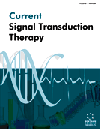- Home
- A-Z Publications
- Current Signal Transduction Therapy
- Previous Issues
- Volume 2, Issue 3, 2007
Current Signal Transduction Therapy - Volume 2, Issue 3, 2007
Volume 2, Issue 3, 2007
-
-
The Role of IL-15 Signaling in the Induction of Innate Antiviral Responses
More LessAuthors: Navkiran Gill, Nicole M. Lauzon and Ali A. AshkarInnate immunity plays a critical role against viral infections, acting as the first line of defense against pathogens. Innate antiviral cytokines are induced early in protection and play a vital role in clearance of the infection and survival of the host. Interleukin 15 (IL- 15) is a cytokine that has been implicated in the establishment of an antiviral state. It is part of the 4-alpha helix bundle family, and shares the IL-2Rβ and the co Read More
-
-
-
A Clinical View of BDNF-TrkB Signaling in the Treatment of Major Depression
More LessMajor depressive disorder is a common mental disease with unknown aetiology. Recent pre-clinical and clinical studies have suggested that the receptor tropomyosin related kinase B (TrkB) and its ligand, brain derived neurotrophic factor (BDNF), play essential roles in the pathogenesis and treatment of major depression. BDNF-TrkB pathway down-regulation may be the most important cause of major depression, while treat Read More
-
-
-
Fluoride Interactions: From Molecules to Disease
More LessAuthors: Anna Strunecka, Jiri Patocka, Russell L. Blaylock and Niloufer J. ChinoyFluoride has long been known to influence the activity of various enzymes in vitro. Later it has been demonstrated that many effects primarily attributed to fluoride are caused by synergistic action of fluoride plus aluminum. Aluminofluoride complexes have been widely used as analogues of phosphate groups to study phosphoryl transfer reactions and heterotrimeric G proteins involvement. A number of reports on their use h Read More
-
-
-
The Role of Epithelial-Mesenchymal Interactions in Tissue Repair, Fibrogenesis and Carcinogenesis
More LessAuthors: D. V. Do, A. Mukhopadhyay, I. J. Lim and T. T. PhanThe epithelium and the mesenchyme comprise the two important cellular partitions found in virtually every organ, and one influence the other via paracrine and cell-cell interactions. These epithelial-mesenchymal interactions have been shown to play important roles for normal tissue development during embryogenesis, and also exert crucial roles in the adult, being involved in roles as diverse as mammary gland devel Read More
-
-
-
Manipulation of Signal Transduction by Botulinum Neurotoxins and their Derivatives
More LessAuthors: John A. Chaddock and Keith A. FosterBotulinum neurotoxins produced by various Clostridium sp are the most potent acute lethal toxins known, and yet they have found increasing use in the clinical treatment of diseases or conditions involving neuromuscular or autonomic neuronal transmission. By a process involving proteolytic cleavage of one or more SNARE (soluble N-ethylmaleimide-sensitive factor attachment protein receptor) proteins, botulinum toxins inhib Read More
-
-
-
Redox Homeostasis, Bioactive Agents and Transduction Therapy
More LessOxidative stress is a key modulator, which modifies the ligand-receptor interactions extracellularly and intracellularly, and influences gene expression. Free radicals can act as secondary messengers in several transduction pathways, and take part in the activation of chemotactic cytokines and surface adhesion molecules etc. Oxidative stress can induce stress response genes, and moderate oxidative stress by do Read More
-
-
-
Signal Transduction by the Cytoplasmic Domain of NEUREGULIN-1 and its Roles During Neuronal Aging
More LessBy Jianxin BaoTransmembrane isoforms of Neuregulin-1 (NRG1) contain an extracellular domain, a transmembrane domain, and a highly conserved intracellular domain. Several recent findings suggest a role of NRG1 signaling in synaptic maintenance and possibly neurodegenerative diseases. The extracellular domain of NRG1 binds to the ErbB family of receptor tyrosine kinases to activate signaling cascades in target cells. This “fo Read More
-
-
-
The Phosphoinositide 3-Kinase (PI3K)/AKT Signaling Pathway as a Therapeutic Target for the Treatment of Human Acute Myeloid Leukemia (AML)
More LessThe PI3K/Akt signaling network regulates cell growth and apoptosis, and its constitutive activation has been implicated in the pathogenesis of a variety of malignancies. Recent studies suggest that PI3K/Akt signaling is frequently up-regulated in blast cells from AML patients and strongly contributes to proliferation, survival, and drug-resistance of these cells. Up-regulation of this network in AML may due to several reasons Read More
-
-
-
Erratum
More LessThe first and last names of authors were mistakenly inverted in the article entitled “The role of connexins in carcinogenesis: review of current knowledge” Current Signal Transduction Therapy January 2007, Vol. 2(1): 49-56. The correct first and last names of the authors are as follows: Kanczuga-Koda Luiza, Sulkowski Stanislaw, Koda Mariusz, Wincewicz Andrzej, Rutkowski Ryszard, Moniuszko Tadeusz, Sulkowska Mariola.
-
Volumes & issues
-
Volume 20 (2025)
-
Volume 19 (2024)
-
Volume 18 (2023)
-
Volume 17 (2022)
-
Volume 16 (2021)
-
Volume 15 (2020)
-
Volume 14 (2019)
-
Volume 13 (2018)
-
Volume 12 (2017)
-
Volume 11 (2016)
-
Volume 10 (2015)
-
Volume 9 (2014)
-
Volume 8 (2013)
-
Volume 7 (2012)
-
Volume 6 (2011)
-
Volume 5 (2010)
-
Volume 4 (2009)
-
Volume 3 (2008)
-
Volume 2 (2007)
-
Volume 1 (2006)
Most Read This Month
Article
content/journals/cst
Journal
10
5
false
en


